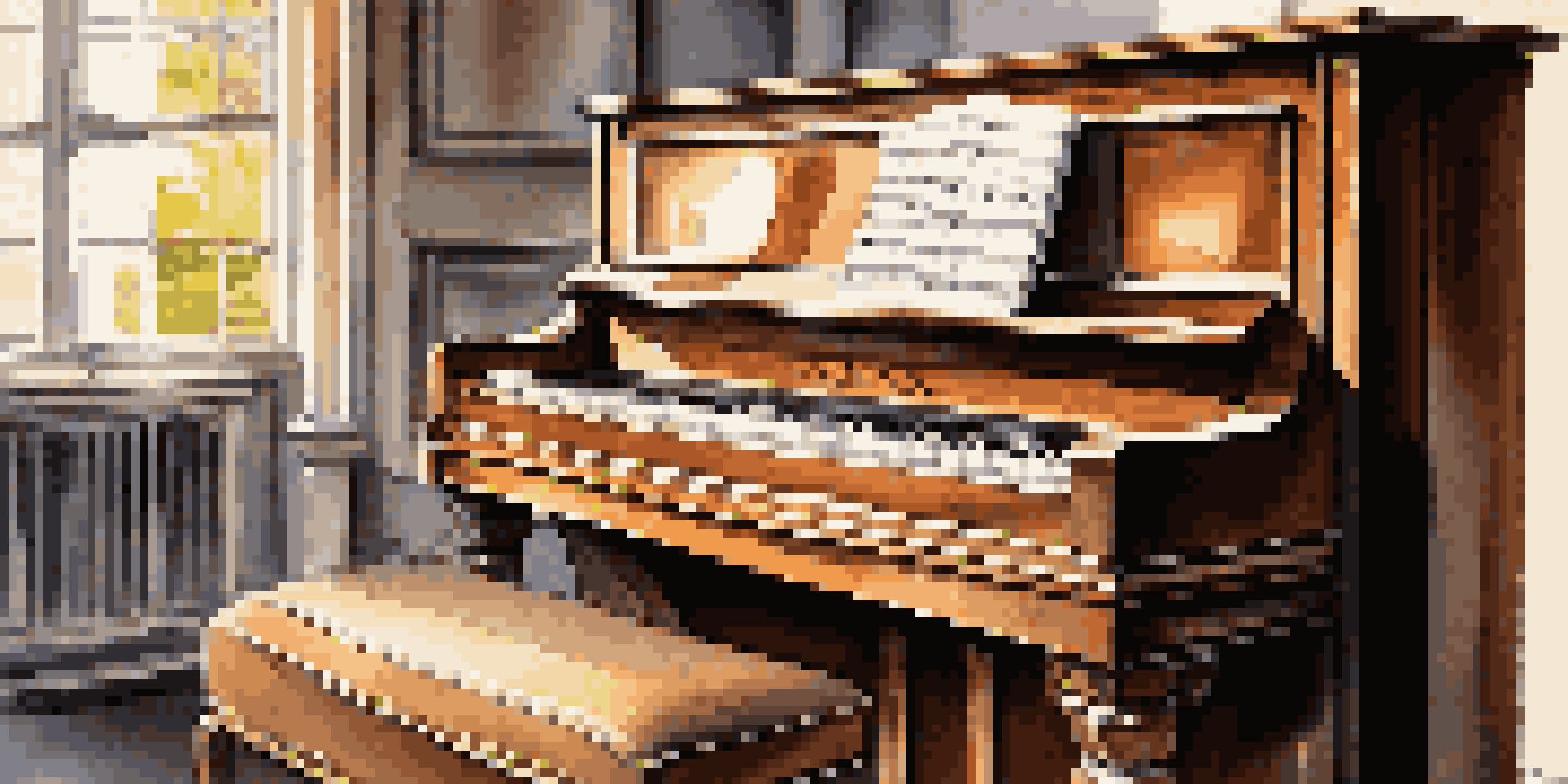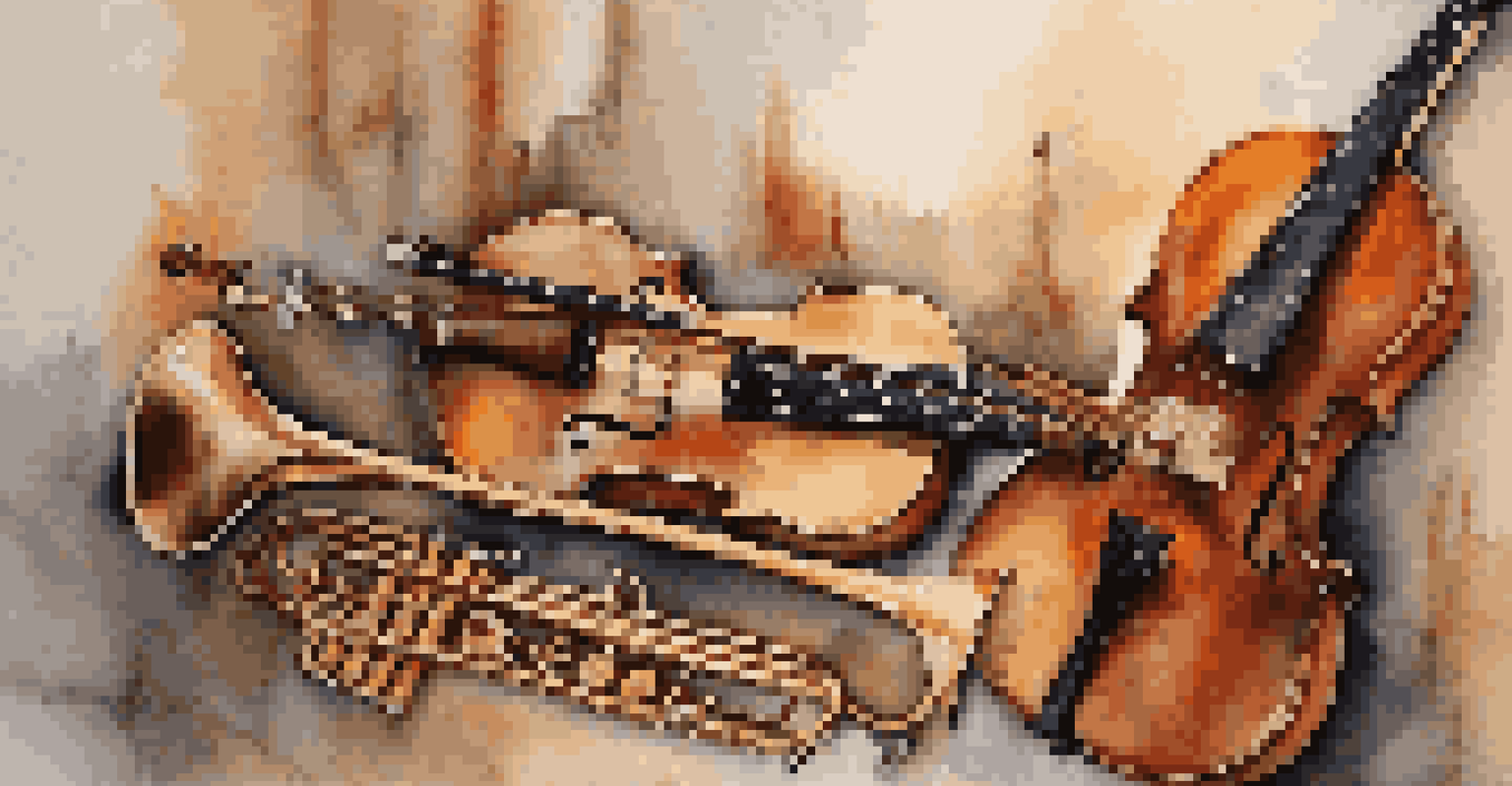Composing for Various Instruments: Techniques and Considerations

Understanding Instrument Range and Capabilities
Every instrument has its own unique range and sound palette. For instance, a piano can produce a wide variety of pitches and dynamics, while a flute offers a more delicate timbre. Understanding these differences is crucial for effective composition, as it ensures that you're writing within the instrument's capabilities.
Music is the shorthand of emotion.
Additionally, each instrument has specific techniques that can be employed, from bowing on strings to breath control in woodwinds. Familiarizing yourself with these techniques can inspire creative ideas and help you craft parts that players will enjoy performing. After all, a piece that highlights an instrument's strengths will resonate more with both the musician and the audience.
Lastly, consider the context in which the piece will be performed. Whether it's a solo performance or part of an ensemble can significantly influence how you approach writing for each instrument. Tailoring your composition based on these factors can lead to a more engaging musical experience.
Exploring Different Musical Styles and Genres
Different musical styles have distinct characteristics that affect how instruments are used. For example, jazz often incorporates improvisation and syncopated rhythms, while classical music may emphasize formal structures and harmonies. Understanding these stylistic nuances can help you compose more effectively for specific instruments.

When writing for a particular genre, it's also important to consider the cultural background of the instruments involved. Instruments like the sitar or the shamisen carry unique historical and traditional significance that can influence how they should be represented in your music. Embracing these elements can add authenticity to your composition.
Understand Instrument Capabilities
Knowing each instrument's range and techniques enhances composition and performance.
Moreover, blending styles can lead to innovative compositions that surprise and delight listeners. By experimenting with different genres, you can discover new ways to utilize instruments, creating a fresh sound that stands out in today's diverse musical landscape.
Utilizing Dynamics and Articulation
Dynamics and articulation are essential elements in composing music that resonates. Dynamics refer to the volume of the music, while articulation describes how notes are played, such as staccato or legato. Incorporating these elements thoughtfully can enhance the emotional impact of your piece.
The music is not in the notes, but in the silence between.
For example, consider how a crescendo can build tension and excitement, particularly in a dramatic climax. Similarly, using varied articulations can bring a sense of character and playfulness to a melody. These techniques allow for greater expressiveness and can make your composition more engaging for both performers and listeners.
It's also worthwhile to remember that different instruments respond uniquely to dynamic markings and articulations. A brass instrument might project a loud passage brilliantly, while a string instrument may require more nuanced bowing techniques. Being aware of these differences can help you create a well-balanced and compelling composition.
Incorporating Harmony and Counterpoint
Harmony and counterpoint are foundational concepts in music composition. Harmony refers to the combination of different musical notes played simultaneously, while counterpoint involves the relationship between independent melodic lines. Mastering these techniques can elevate your compositions, adding depth and richness.
When composing for multiple instruments, consider how they can interact harmonically. For instance, a string section can provide lush chords, while a woodwind section complements with melodic lines. This interplay can create a full, textured sound that captivates audiences.
Embrace Musical Styles and Genres
Recognizing stylistic differences and cultural contexts of instruments enriches your compositions.
Counterpoint, on the other hand, allows for creative conversations between instruments. By weaving together distinct melodies that complement each other, you can craft intricate musical dialogues that engage listeners. Exploring these concepts can lead to innovative compositions that stand out in any repertoire.
Understanding Instrument-Specific Notation
Notation can vary significantly between instruments, and understanding these differences is crucial for effective communication. For instance, brass instruments often use treble clef, while bassoons are written in bass clef. Being mindful of these notational differences ensures that musicians can read and interpret your score accurately.
Moreover, some instruments have specific notation requirements, such as string instruments that might require fingerings or bowing directions. Including these details can help performers deliver your composition as you envision it. It's about creating a clear roadmap for musicians to follow.
Additionally, consider incorporating performance instructions within your score. Indicating dynamics, articulations, and even emotional cues can guide musicians in bringing your piece to life. This attention to detail not only aids performers but also enhances the overall interpretation of your composition.
Balancing Texture and Density in Composition
Texture refers to how different musical lines interact within a piece, while density describes how many layers of sound are present. Achieving the right balance between these elements is crucial for effective composition. A well-balanced texture allows each instrument to shine without overwhelming the others.
When writing for multiple instruments, consider how they can complement each other. For example, a sparse texture might highlight a soloist, while a denser texture can create a rich tapestry of sound in an ensemble piece. Varying the texture throughout your composition can maintain listener interest and create dynamic contrasts.
Collaborate for Enhanced Compositions
Working closely with musicians can provide insights that lead to more effective and engaging music.
Moreover, think about how to layer different instrumental timbres to add depth. Combining instruments with contrasting colors—like the warm sound of a cello with the bright tones of a trumpet—can create a compelling auditory experience. This layering can evoke a range of emotions and keep your audience engaged.
Experimenting with Form and Structure
The structure of a composition plays a vital role in how the music unfolds. Traditional forms like sonata or rondo provide frameworks that can guide your writing. However, experimenting with these structures can lead to unique and innovative compositions that break the mold.
Consider how different sections of your piece can transition smoothly from one to another. Using techniques like modulation or thematic development can create cohesion and keep listeners engaged. These transitions can also build anticipation for what comes next, enhancing the overall experience.

Additionally, don’t shy away from unconventional forms. Free-form compositions can allow for greater creativity and exploration of themes. By stepping outside traditional boundaries, you may discover new ways to express your musical ideas and inspire both performers and audiences.
Collaborating with Musicians for Better Outcomes
Collaboration with musicians can significantly enhance your compositions. Engaging with performers during the writing process allows you to gain valuable insight into their instrument's capabilities and limitations. This partnership can lead to more effective writing and a greater sense of ownership over the music.
Furthermore, musicians can offer feedback on your compositions, helping you refine your ideas. Whether it's adjusting a challenging passage or exploring alternative interpretations, their input can strengthen your work. Building these relationships fosters a creative atmosphere where ideas can flourish.
Finally, consider hosting workshops or reading sessions with musicians. Hearing your compositions performed live can provide critical insights into what works and what doesn’t. This collaborative approach can ultimately elevate your music and create a more fulfilling experience for both you and the performers.